介绍景德镇中英文 对照PPT
景德镇英文介绍
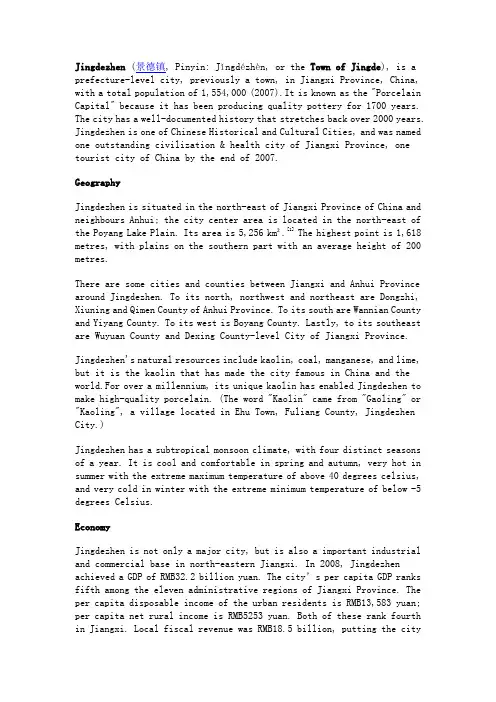
Jingdezhen (景德镇, Pinyin: Jǐngdézhèn, or the Town of Jingde), is a prefecture-level city, previously a town, in Jiangxi Province, China, with a total population of 1,554,000 (2007).It is known as the "Porcelain Capital" because it has been producing quality pottery for 1700 years. The city has a well-documented history that stretches back over 2000 years. Jingdezhen is one of Chinese Historical and Cultural Cities, and was named one outstanding civilization & health city of Jiangxi Province, one tourist city of China by the end of 2007.GeographyJingdezhen is situated in the north-east of Jiangxi Province of China and neighbours Anhui; the city center area is located in the north-east of the Poyang Lake Plain. Its area is 5,256 km².[1]The highest point is 1,618 metres, with plains on the southern part with an average height of 200 metres.There are some cities and counties between Jiangxi and Anhui Province around Jingdezhen. To its north, northwest and northeast are Dongzhi, Xiuning and Qimen County of Anhui Province. To its south are Wannian County and Yiyang County. To its west is Boyang County. Lastly, to its southeast are Wuyuan County and Dexing County-level City of Jiangxi Province.Jingdezhen's natural resources include kaolin, coal, manganese, and lime, but it is the kaolin that has made the city famous in China and the world.For over a millennium, its unique kaolin has enabled Jingdezhen to make high-quality porcelain. (The word "Kaolin" came from "Gaoling" or "Kaoling", a village located in Ehu Town, Fuliang County, Jingdezhen City.)Jingdezhen has a subtropical monsoon climate, with four distinct seasons of a year. It is cool and comfortable in spring and autumn, very hot in summer with the extreme maximum temperature of above 40 degrees celsius, and very cold in winter with the extreme minimum temperature of below -5 degrees Celsius.EconomyJingdezhen is not only a major city, but is also a important industrial and commercial base in north-eastern Jiangxi. In 2008, Jingdezhen achieved a GDP of RMB32.2 billion yuan. The city’s per capita GDP ranks fifth among the eleven administrative regions of Jiangxi Province. The per capita disposable income of the urban residents is RMB13,583 yuan; per capita net rural income is RMB5253 yuan. Both of these rank fourth in Jiangxi. Local fiscal revenue was RMB18.5 billion, putting the cityin tenth place, just above Yingtan City. Jingdezhen's GDP and local fiscal revenues are relatively low for Jiangxi Province, but the growth rate is fast. The growth rate of the per capita data is in the middle for the province. [10]Industry The French SA 321 Super Frelon, which Changhe produces under license as the Z-8There are some important industrial enterprises in Jingdezhen City, such as Changhe Aircraft Industries Corporation; Jingdezhen Ceramics; Jingdezhen Refrigeration Compressor, etc.TransportationJingdezhen is the most important transportation hub in the northeast region of Jiangxi province. Historically, Jingdezhen's main communication route was via the Chang River. It could ship its porcelain down the Chang to Poyang Lake and connected there with the Yangtze River in Hukou County, Jiangxi Province. From there the porcelain could get to the coast for export. Today, water is far less important for transporting goods. Roads, the railway and airlines have grown to be more important forms of transport of goods and people.Local transitThere was only one bus line in Jingdezhen before the 1980s, which was from Huang-ni-tou to Nan-men-tou with a total line distance of 7 kilometers. In that time , the city had no taxi service and the buses were channel-type bus, it could carry more than one hundred passengers at most at the same time. This kinds of buses were renewed when they were operated to the end of 1990s.Currently,Jingdezhen public buses and taxis are the two main means of transportation within the city. Nearly more than 20 public bus lines crisscross the city and its countryside. Taxis in Jingdezhen are plentiful; fares start at ¥5 for the first 2 kilometers.EducationJingdezhen city has three colleges or universities, and these have a total of 38,613 students and 1,306 teachers in 2007. It is also the home of the Jingdezhen Ceramic Institute (JCI), which was established in 1958. It is the only institute in China that provides advanced ceramics training and it is also well-known in Chinese and international academic circles in the field of ceramics. The other two institutions of higher educationin the city are the Jiangxi Ceramics & Art Institute and Jingdezhen College.In the city proper there are 47 high schools, called Middle Schools, with 37,200 students and 2,953 teachers. The No.1 Middle School of Jingdezhen was founded in 1940. It is famous for its success rate, relative to other schools in Jiangxi Province, in placing its students in Chinese colleges.There are also 74 primary schools in the city with 40,000 students and 1,884 teachers.Public healthJingdezhen has more than 20 medical service institutions with a total 2182 beds. Doctors and nurses number 2,672. It has the largest hospital system in the north-east of Jiangxi Province. The No.1, No.2 and No.3 People's Hospital of Jingdezhen are the most important hospitals in the city; the No.4 People's Hospital is a psychiatric hospital.Tourism and local customHuizhou architecture (Anhui Province) in Yaoli town, Fuliang county[edit] Travel OverviewJingdezhen is a major tourism destination in northern Jiangxi Province. Most of the city's tourist attractions have a link to the ceramics for which it is famous.[2] The city also provides access to nearby popular tourist areas such as Lushan, Huangshan, and Wuyuan.In 2007, Jingdezhen City earned RMB3.027 billion yuan in revenues from tourism. Tourism accounted for 11.2% of local GDP, up from its share in 2006. The number of visitors is also rising year by year as the city's transportation links to the rest of China improve.At present, Jingdezhen has the most tourist hotels of any city in Jiangxi Province. In the city there is one quasi-five-star hotel, two four-star hotels, and many three-star and other common grade hotels.Jingdezhen is located in Huangshan, Huai Yu Shan Mountains and the Poyang Lake Plain transition zone, both Chinese and foreign famous porcelain, and Foshan, Hankou, zhuxianzhen adding four famous towns, JingdezhenChina State Council announced the first 24 historical and cultural city A one and open city. By 2007, Jingdezhen has received excellent tourist city in China, the National Ecological Garden City, National Civilized Sanitary City, Jiangxi Province civilized Advanced City and so on.Over the past Jingdezhen porcelain is world famous, but now has been not so famous Jingdezhen ceramics提到江西,大家是不是马上就想到了景德镇的陶瓷?上海世博会江西馆就充分利用了这一闻名遐迩的“特产”,将外形设计成青花瓷容器。
瓷器英文PPT
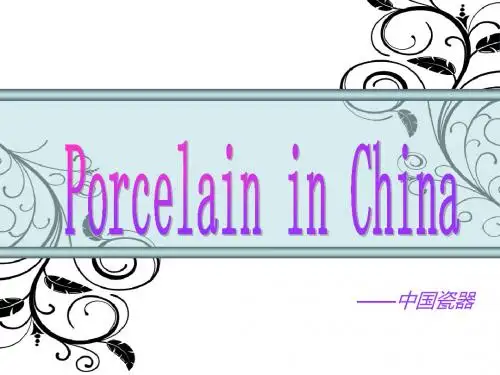
清雍正 柠檬黄地洋彩浮雕花鸟宝瓶纹六方瓶
Qing Emperor Yongzheng
Poly 2009 Spring Auction Price RMB : 67,760,000
Qing Emperor Guangxu 粉彩九桃玉壶春
Poly 2009 Spring Auction Price RMB : 60,000~90,000
Qing Emperor Jiaqing 黄地粉彩花卉高足盘 Poly 2009 Spring Auction Price RMB : 224,000
Qing Emperor Qianlong 白地粉彩八宝纹炉 Poly 2009 Spring Auction Price RMB : 224,000
Famille-rose porcelain
“Pearl in the East”---pastel drawing beads 有“东方明珠”之称的粉彩瓷珠
Qing Emperor Qianlong
清乾隆 粉彩七珍象 马
Poly 2009 Spring Auction Price: RMB 403,200
Qing Emperor Daoguang 黄地粉彩花卉碗(一对) Poly 2009 Spring Auction Price RMB : 224,000
Glowing porcelain玲珑瓷
Glowingporcelain, as blue and white porcelain,color glazeporcelain, famile-rose porcelain,is one of four tradition and famous china.
Color glaze porcelain
英语介绍我的家乡江西省景德镇市
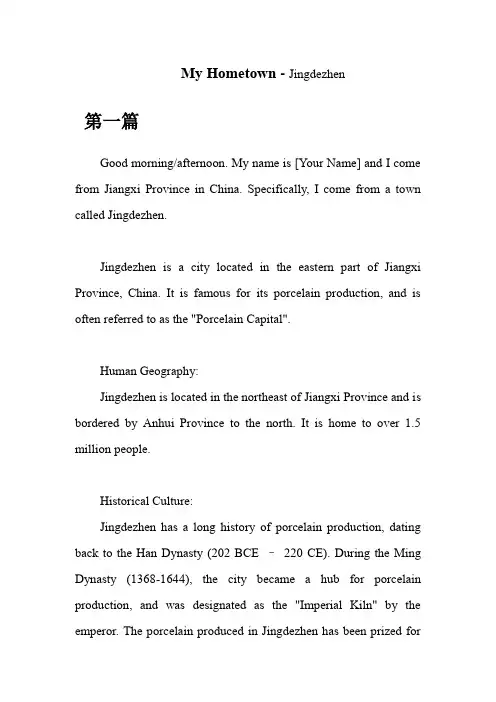
My Hometown -Jingdezhen第一篇Good morning/afternoon. My name is [Your Name] and I come from Jiangxi Province in China. Specifically, I come from a town called Jingdezhen.Jingdezhen is a city located in the eastern part of Jiangxi Province, China. It is famous for its porcelain production, and is often referred to as the "Porcelain Capital".Human Geography:Jingdezhen is located in the northeast of Jiangxi Province and is bordered by Anhui Province to the north. It is home to over 1.5 million people.Historical Culture:Jingdezhen has a long history of porcelain production, dating back to the Han Dynasty (202 BCE –220 CE). During the Ming Dynasty (1368-1644), the city became a hub for porcelain production, and was designated as the "Imperial Kiln" by the emperor. The porcelain produced in Jingdezhen has been prized forits exquisite craftsmanship and artistic beauty, and has been exported around the world.Attractions:Jingdezhen has a number of attractions for tourists. The Jingdezhen Ceramic Museum is a must-see for those interested in porcelain. It features a large collection of porcelain from different dynasties, as well as exhibits on the history of porcelain production in Jingdezhen. The Ancient Kiln Folk Customs Museum is another popular attraction, showcasing the traditional methods of porcelain production. Additionally, the city has a number of temples and historic sites, such as the Taoist temple of Dragon Light Palace and the Ming Dynasty Porcelain Pagoda.Tourism Resources:Apart from its porcelain heritage, Jingdezhen also boasts beautiful natural scenery. Lushan Mountain, located to the south of the city, is a popular destination for hiking and sightseeing. The Yangtze River also flows through the city, providing opportunities for river cruises.Specialty Food:Jingdezhen has a rich culinary tradition, with its own unique local dishes. One of the most famous is Taoxi Meat, a braised pork dish that is traditionally served during festive occasions. Other popular dishes include fish soup, Jingdezhen-style tofu, and fried rice with porcelain shard.Economic Development:Jingdezhen is a developing city, with a growing economy. The city is home to several high-tech industries, including electronic information, biomedicine, and new materials. Additionally, the porcelain industry remains a major contributor to the local economy, with over 100,000 people employed in the industry.Overall, Jingdezhen is a city with a rich cultural heritage, stunning natural scenery, and exciting economic prospects. It is a must-visit destination for those interested in porcelain, history, and Chinese culture.That's all for my introduction of Jingdezhen. If you have any questions about my hometown, feel free to ask me. Thank you!第二篇Jingdezhen, located in the eastern part of Jiangxi Province, is a city with rich cultural and historical significance. The city is known for its porcelain industry and is often referred to as the "Porcelain Capital" of China.As for its human geography, Jingdezhen is surrounded by mountains and rivers, providing a picturesque view. The city has a population of over 1.5 million people and is a mix of different ethnic groups, including Han, Hui, Miao, and Zhuang.Jingdezhen has a long and significant history, dating back over 1,700 years, and is considered one of the birthplaces of ceramic art in China. The city's porcelain industry has been renowned for thousands of years and has played a significant role in shaping the culture and economy of the region.There are numerous famous historical and cultural sites in Jingdezhen, including the Ancient Kiln Folk Customs Museum, the Porcelain Museum, and the Jingdezhen Ceramic History Museum. Additionally, the city has many beautiful temples and pagodas, suchas the Jingdezhen Pagoda and the Taoist Temple of the Five Immortals.Jingdezhen has many tourist resources, such as the Changjiang River National Forest Park, Nine-dragon Cave Scenic Area, and the Dragon Pearl Scenic Area. The city has also developed many high-end hot spring resorts that offer various spa services and scenic views.When it comes to food, Jingdezhen is famous for its local cuisine, including Jingdezhen beef noodles, Jingdezhen fried rice noodles, and Jingdezhen hot pot. These dishes are flavorful and unique, and visitors to the city should make sure to try them.In terms of economic development, Jingdezhen has experienced significant growth in recent years, with the porcelain industry driving much of the city's economy. The city is also known for its furniture and handicraft industries, which contribute to the overall economic growth of the region.Overall, Jingdezhen is a vibrant and culturally rich city with endless tourist attractions and resources. Its unique history,picturesque scenery, and delicious cuisine make it a must-visit destination in China.That's all for my introduction of Jingdezhen. If you have any questions about my hometown, feel free to ask me. Thank you!第三篇Jingdezhen, located in Jiangxi Province, is a renowned city in China for its rich history, culture, and scenic attractions. It is home to a population of over 1.5 million people, and has a diverse geography with mountains, rivers, and lakes.The city boasts a long history dating back to the Han Dynasty, and has been a center for ceramic production since the Tang Dynasty. Its rich cultural heritage is reflected in the numerous temples, museums, and historic sites such as the Ancient Kiln Folk Customs Museum, Jingdezhen Ceramic Museum, and the Imperial Kiln Ruins from the Ming and Qing Dynasties.The city is known for its beautiful scenic spots, such as the Lushan Mountain Scenic Area, Longzhu Lake, and YueliangwanPark. These attractions draw tourists from around the world and contribute to the city's thriving tourism industry. In addition, Jingdezhen is home to many famous porcelain manufacturers and is known as the "Porcelain Capital" of China, making it an ideal destination for those interested in traditional Chinese arts and crafts.Jingdezhen is also famous for its delicious local cuisine, including Steamed Fish Head, Jingdezhen Noodles, and Fish in Sour Soup. These dishes use local ingredients and are prepared according to traditional recipes, offering a unique culinary experience for visitors.In recent years, Jingdezhen has developed rapidly and has become an important economic hub in the region, with industries such as ceramics, tourism, and agriculture contributing to its growth. The city is also home to several colleges and universities, including Jingdezhen Ceramic Institute, which attracts students from around the world to study ceramics and the arts.In summary, Jingdezhen is a city with a rich cultural heritage, breathtaking scenery, and unique local cuisine. Its rapid development and economic growth make it an exciting and dynamic place to visit,and a recommended destination for anyone interested in Chinese history, culture, and art.That's all for my introduction of Jingdezhen. If you have any questions about my hometown, feel free to ask me. Thank you!。
景德镇 英文介绍
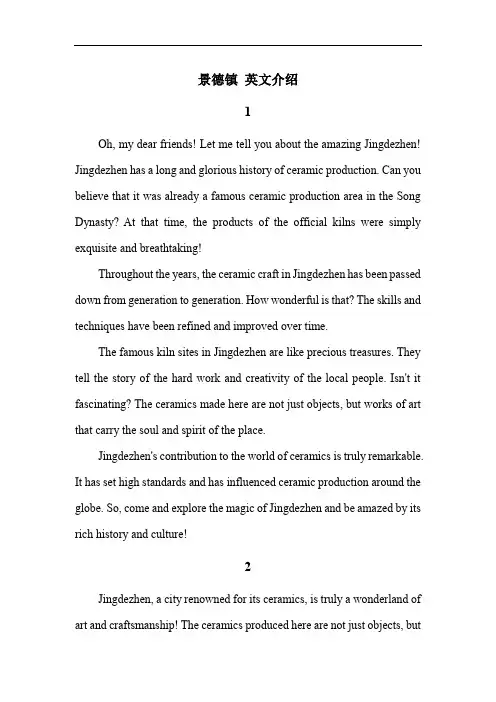
景德镇英文介绍1Oh, my dear friends! Let me tell you about the amazing Jingdezhen! Jingdezhen has a long and glorious history of ceramic production. Can you believe that it was already a famous ceramic production area in the Song Dynasty? At that time, the products of the official kilns were simply exquisite and breathtaking!Throughout the years, the ceramic craft in Jingdezhen has been passed down from generation to generation. How wonderful is that? The skills and techniques have been refined and improved over time.The famous kiln sites in Jingdezhen are like precious treasures. They tell the story of the hard work and creativity of the local people. Isn't it fascinating? The ceramics made here are not just objects, but works of art that carry the soul and spirit of the place.Jingdezhen's contribution to the world of ceramics is truly remarkable. It has set high standards and has influenced ceramic production around the globe. So, come and explore the magic of Jingdezhen and be amazed by its rich history and culture!2Jingdezhen, a city renowned for its ceramics, is truly a wonderland of art and craftsmanship! The ceramics produced here are not just objects, butmasterpieces that carry history and culture.The glaze colors in Jingdezhen are simply astonishing! The rich and vibrant hues, like the deep blue of the blue and white porcelain or the soft pastels of the famille rose porcelain, are like a symphony of colors. The craftsmanship is beyond imagination! Skilled artisans meticulously shape and decorate each piece, showing extraordinary patience and precision.Take the elegant blue and white porcelain for example. Its patterns are so delicate and refined, as if telling stories of ancient times. And the famille rose porcelain, with its fine details and smooth texture, makes one wonder how such beauty can be achieved.The variety of shapes is also remarkable. From delicate vases to elaborate figurines, each piece is a unique creation. How can one not be amazed by the creativity and artistry displayed in these ceramics?In Jingdezhen, the world of ceramics is a never-ending source of inspiration and awe. It's a place where tradition and innovation blend seamlessly, creating masterpieces that will continue to fascinate people for generations to come!3Jingdezhen, a remarkable city in China, is renowned worldwide for its outstanding ceramic industry. It is located in a strategic geographical position that plays a crucial role in its success. The rich natural environment of Jingdezhen has been a significant contributor to itsflourishing ceramic production.The abundant kaolin clay resources in this area are truly a wonder! How amazing it is that these high-quality materials provide a solid foundation for the creation of exquisite ceramics. Without this precious resource, the exquisite porcelain we admire today might not exist.The local climate conditions are also a key factor. The moderate temperature and humidity are perfect for the firing process of ceramics. Isn't it astonishing how nature cooperates so well to support this ancient art? The combination of these geographical and environmental advantages has made Jingdezhen a unique and irreplaceable hub of ceramic production.In conclusion, the location and natural environment of Jingdezhen have undoubtedly had a profound and positive impact on its ceramic industry. This city stands as a shining example of how nature and human craftsmanship can come together to create something truly remarkable.4Oh my goodness! Let me tell you about the amazing Jingdezhen and its ceramic industry! Jingdezhen, a city renowned for its ceramics, has witnessed remarkable developments in recent times. The modern technology has truly been a game-changer in the ceramic production process! Advanced techniques and machinery have enabled artisans to create more intricate and exquisite designs. How astonishing is that?Today, the ceramics from Jingdezhen are not only of high quality butalso showcase a perfect blend of tradition and innovation. The attention to detail and the pursuit of perfection are still at the core of every piece.What's more, the future of Jingdezhen's ceramics looks incredibly bright! With its unique charm and superior craftsmanship, these ceramics are set to make a splash in the international market. Isn't it exciting to think about? They will surely capture the hearts of people from all over the world.In conclusion, Jingdezhen's ceramic industry is flourishing and has a promising future ahead. It continues to be a source of pride and inspiration. So, keep your eyes on this wonderful place and its amazing ceramics!5Jingdezhen, a city renowned worldwide for its exquisite ceramics, has played an indispensable role in cultural exchanges! The porcelain produced in Jingdezhen is not merely an art form but a messenger that bridges the gap between different cultures. How remarkable it is! For instance, the unique blue and white porcelain of Jingdezhen has charmed countless foreigners. They are astonished by the delicate patterns and superb craftsmanship. Isn't it a wonder that these ceramics have sparked interest and admiration in foreign lands?In international exhibitions, works from Jingdezhen always attract the most attention. The vivid colors and intricate designs of the ceramics tell stories of China's long history and rich culture. Oh, how they have opened the door for people from all over the world to understand the depth andbeauty of Chinese culture!The ceramics from Jingdezhen have become a symbol of cultural exchange, spreading the charm of Chinese art to every corner of the world. How could we not praise the significant contribution of Jingdezhen ceramics in facilitating cultural communication? They truly are a precious treasure that continues to shine on the global stage!。
景德镇瓷器英语演讲课件
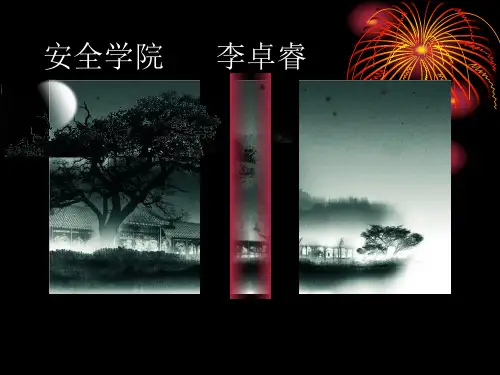
Colored galze porcelain
颜色釉瓷是景德镇传统四大名瓷之一, 它是在釉料里加上某种氧化金属,经 过焙烧以后,就会显现出某种固有的 色泽。这类瓷器,釉面斑驳璀灿,呈 色五彩缤纷。人们说“自然界有什么 颜色,就可以烧出什么颜色的瓷器”。
People always says “the porcelain wares of any kind of color canbe made if the nature owns”.
青花玲珑瓷属景德镇四大传统 名瓷之一,又称“米通瓷”, 外国朋友则称之为“嵌玻璃的 瓷器”。这一产品是在同一件 瓷器上,既绘有青翠欲滴的 “青花”,又布有碧绿透明的 “玲珑”,二者互相衬托,相nship
famille rose porcelain
粉彩亦称软彩,它画工细腻工整, 画面充满着浓郁的民族特色,线条 纤细秀丽,形象生动逼真,色彩粉 润柔和,富有立体感,深受国内外 朋友喜爱,人们称它为“玫瑰族瓷 器”、“东方艺术的明珠”。
developed and spread quickly after its emergence.
景德镇青花瓷,被人们称为“世界瓷坛珍 品”。江西景德镇最好的青花瓷出现元朝。 青花瓷的出现在瓷历史上有重要意义,之后发 展和发展较快。
Blue and white porcelain produce in high temperature (1200 degrees) a time firing, the characteristic is lively, pure and fresh, elegant。
安全学院
李卓睿
孙菲Sophy
Porcelain capital of China ——jingdezhen Jingdezhen is located in
景德镇介绍(英文版)
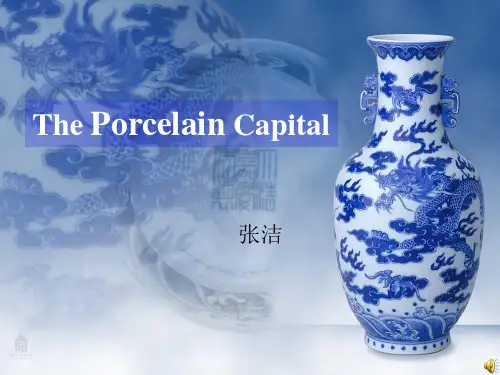
The Porcelain Capital
Байду номын сангаас
张洁
The main content
• Jingdezhen City • Porcelain
Jingdezhen
• A town in the past
• A well-documented history stretching
History
①Qin dynasty a. County Jiujiang ②Han dynasty b. Xinpingzhen producing pottery and porcelain ③Tang dynasty d. Changnanzhen ④Northern Song dynasty e.
Climate
Jingdezhen has a four-season, monsoon-influenced, humid subtropical climate, with somewhat brief, cool and damp winters, and long, very hot and humid summers.
Porcelain
Species: Blue and white porcelain Colored glaze porcelain Colorful famile - rose porcelain Exquisite porcelain Thin tire porcelain Sculpture porcelain
Characteristics
as as as as thin as paper white as jade bright as a mirror sound as a bell
介绍景德镇中英文 对照 ppt课件
1
炼泥 Milling
2
3
摞泥 Filter press 介绍景德镇中英文 对照 制坯 Green Making
4
5
贴花 Lithography 6
上釉 Glazing 7
介绍景德镇中英文 对照
修坯 Finishing
烧釉 Glost firing
景德镇四大名瓷
介绍景青德镇花中英瓷文 对照 Blue And White Porcelain
青花瓷创烧于元代,是以色料在坯胎上描绘纹样, 施釉后经高温烧成,釉色晶莹、雅致。青料溶于胎釉 之间,发色青翠,虽色相单一,但感觉丰富。青花瓷 经久耐用,瓷不碎,色不褪。
Blue and white porcelain was first appeared in the Yuan Dynasty. It was formed by using pigment to depict patterns on the green body and firing at high temperature after glazing. The glazing color is glittering and elegant. The green pigment dissolve in green body, showing a verdant color. Although it has single hue, it still gives people rich feeling. Blue and white porcelain is durable。 it will not fade until broken
1700 years. The city has a well-documented history that stretches
浅谈江西旅游景点推介英译PPT课件
龙虎山:仙境龙虎,人间奇观
总结词
体现神秘与壮丽
详细描述
龙虎山的宣传语传达了一种神秘和壮丽的感觉,英译时需要 保留这种氛围,让游客感受到龙虎山的神奇和壮美。
三清山:三清天下秀,奇峰异石多
总结词
突出自然风光与地质特色
详细描述
三清山的宣传语强调了自然风光和地 质特色,英译时需要突出这两个方面, 让游客了解三清山的美丽景色和独特 的地质景观。
井冈山的红色旅游资源非常丰富,游客可以了解中国革命历史和感受红 军精神。
龙虎山
龙虎山是中国著名的道教名山之一,位 于江西省鹰潭市境内。
龙虎山的道教文化源远流长,有着众多 的道观和寺庙,如天师府、玉皇顶等。 此外,龙虎山的山水景观也非常秀美,
如九曲洲、仙女岩等。
龙虎山的道教文化和自然景观相融合, 吸引了大量游客前来观光和体验道教文
浅谈江西旅游景点推介英 译PPT课件
• 引言 • 江西旅游景点介绍 • 景点名称及特色翻译 • 景点推介宣传语翻译 • 结语
01
引言
目的和背景
促进江西旅游国际化
01
通过英译PPT课件,向国际游客宣传和推介江西的旅游资源,提
升江西的国际知名度和旅游吸引力。
推动江西旅游产业发展
02
通过吸引更多国际游客,促进江西旅游产业的繁荣和发展,带
04
景点推介宣传语翻译
庐山:遨游庐山,尽享自然之美
总结词
准确传达原意
详细描述
庐山的宣传语强调了自然之美, 因此在英译时需要准确传达出原 意,让游客感受到庐山的壮丽景 色和丰富的自然资源。
井冈山:红色井冈,绿色家园
总结词
突出红色文化与生态特色
详细描述
井冈山的宣传语突出了红色文化和生 态特色,英译时需要强调这两个方面 ,让游客了解井冈山的红色历史和美 丽的自然环境。
Jingdezhen瓷都景德镇英文介绍
Jingdezhen, Porcelain Capital of ChinaTravel in JiangxiJingdezhen (jǐng dé zhèn 景德镇), known as the "Porcelain Capital" of China, has a long history and a magnificent culture. It is located on the south of the Yangtze, between the Huangshan Mountain(huáng shān 黄山) range and the plains of Poyang Lake (pó yáng hú 鄱阳湖). It is one of the four famous towns in Chinese history, designated one of the first 24 famous Chinese cities of historical and cultural interests and a first-rate city opening to the foreigners by China's State Council.Endowed by nature with a network of rivers and hills, Jingdezhen is a municipality directly under the provincial government with a total area of about 5,248 square kilometers and a population of 1.49 million. It is an ancient city with a long history and magnificent culture. The city's reputation for producingfine porcelain began in the Eastern Han Dynasty(dōng hàn 东汉). During the Song Dynasty (sòngdài 宋代) the Jingdezhen workshop wascommissioned to produce porcelain for theimperial court. It enjoys a monsoon subtropical climate. Its climate is characterized by adequate sunshine, sufficient rainfall and obvious distinctions between the four seasons. The annual average temperature in the city is 17 C. The main products are porcelain stone, Kaolin, marble, tea, paddy, soybean, wheat, peanut, rapeseed etc.Since the period of Han Dynasty (hàn dài 汉代), Jingdezhen has had the ceramic industry. Up to now, it has more than 2000 years of history. Traditionally, Jingdezhen was titled Ceramic Capital. Porcelain of Jingdezhen has a beautiful shape, various types, rich decorations and unique styles. It is worldwide famous for its color as white jade, brightness as bright mirror, thinness as paper and sound as music. Qinghua Porcelain (qīng huā 青花), Linglong Porcelain (líng lóng 玲珑), Fencai Porcelain(fěn cǎi 粉彩) and Seyou Porcelain (sè yòu 色釉) altogether are called Four Traditionally Famous Porcelains in Jingdezhen.1. Ancient Porcelain Street (gǔdài cí qì jiē 古代瓷器街)It is in the center of Jingdezhen. It was the most busy and bustling street in the late Ming (míng dài 明代) and early Qing Dynasties(qīng dài 清代), now renowned for its long history and beautiful traditions that come from its ancient culture. The street is composed of three parts, each of which fully reflects itsprosperous past. Exquisitely designed and decorated residences were clearly the elite residences of their time and demonstrate the highest skills and architectural knowledge of Chinese artisans of their eras.• Admission Fee: Free2. Ceramic History Museum (jǐng dé zhèn táo cí bó wù guǎn 景德镇陶瓷博物馆)Located in the western suburb of Jingdezhen City,It is a professional ceramic museum built in 1980,with a rich collection of over 5,000 articles. Theitems on display include ceramics from pastdynasties, historical information about ceramics,precious collections of paintings and calligraphies, among which many are of excellent quality.• Admission Fee: CNY 103. Longzhu Pavilion (lóng zhū gé 龙珠阁)Longzhu Pavilion is located on the top of the Zhushan Mountain (zhū shān 珠山) of Jingdezhen. It is a monument to Jingdezhen's ceramic industry. In the Ming and Qing dynasties, it was a place for making ceramics for the imperial family which means there are a lot of precious culture relics of those two dynasties on display.• Admission Fee: CNY 154. Yuyao Factory (yù yáo chǎng 御窑厂)The early Ming Dynasty, Yuyao factory was established. Yu means, the emperor dedicated. Yao means, Kiln, the place where produce porcelain. China is a country of porcelain, and we can say that the porcelains which Yuyao made during Song, Yuan, Ming and Qing dynasties were the best in the world.• Admission Fee: CNY 155. Fuliang Ancient County Government (fú liáng gǔxiàn yá 浮梁古县衙)The Fuliang Ancient CountyGovernment is in the suburb ofJingdezhen. It is a well preservedancient county government site,which was set up 1,100 years ago.In it, you can see the official robes, sedan chairs and even instruments of torture. Visiting the site of the ancient county government is really a good chance to understand the politics of ancient China.• Admission Fee: CNY 506. Ming Qing Garden (míng qīng yuán 明青园)Ming Qing Garden is located in Jingdezhen porcelain sculpture factory. It is Jingdezhen international ceramics center. Construction of Chinese Ming Dynasty style. The porcelain street is a copy of ancient Jingdezhen. Many artists have studios here,showing intricate art of ceramic sculpture.• Admission Fee: CNY 107. Yaoli (yáo lǐ瑶里)Yaoli is in Fuliang County which is 50 kilometers from downtown Jingdezhen. With good forest coverage, abundant animal resources, characteristic lanes, the town is well-known for its beautiful natural scenery. Additionally, it is the cradle of Jingdezhen's ceramics industry. Gaoling(gāo lǐng 高岭) Village located in Yaoli once provided enough raw materials for making porcelain in the ancient times. Today, Kaolin, a world famous kind of clay, is named according to its Chinese pronunciation.• Admission Fee: CNY 1508. The Moon Lake (yuè liàng hú月亮湖)The Moon Lake Scenic Area lies in Liyang Town(lì yáng xiāng 丽阳). It is 10 kilometers from downtown Jingdezhen. There are many hills and lots of wild birds inhabit the area. It got the name because of its moon-shape. Besides the charming scenery, it has some entertainment facilities, such as motorboats and luxury speed boats and also you can enjoy fishing there.9. Red Tower (hóng tǎ红塔)Because the wall is red, so the tower called Red Tower.By TrainThe WanGan (wǎn gàn 皖赣) Railway (Anhui - Jiangxi) connects Jingdezhen to many key cities in China. The Jingdezhen Railway Station is located in the city center.By AirJingdezhen Airport is located at Luojia Village(luó jiā cūn 罗家村), northwest of Jingdezhen City, about 8 kilometers from the city downtown. There are no international flights.Getting aroundJingdezhen public buses and taxis are the two main means of transportation within the city. Nearly more than 20 public bus lines crisscross the city and itscountryside. Taxis in Jingdezhen are plentiful with fares starting at CNY 5 for the first 2 kilometers.Cold Vermicelli(lěng fěn 冷粉). This is one brand name of Jingdezhen snacks. It is different from vermicelli of other regions. The vermicelli is thicker and has a half centimeter of diameter. It is also has the diversities of seasonings such as bean sauce, pepper sauce, orange peel, garlic and ginger.Jiaoziba (jiǎo zǐbā 饺子粑). Jiaoziba generally is taken as the breakfast and night food. Diversities of stuffing covered by powder-made slice are steamed on steam boxes. Through the thin slices, eaters can see the stuffing clearly. Additionally it has different taste after fried. Generally the stuffing is divided into hot and non-spicy. The spicy stuffing is made of the carrot slices, and the non-spicy stuffing is made of the eggs with leeks. Additionally it also has the stuffing made of the bean sprout and bean-curd.Xianshuiba (jiǎn shuǐpá 碱水耙). This is the classical snack in Jingdezhen. Xianshuiba generally is unavailable in other areas, and it can be eaten during the time of Lunar Spring Festival. It is delicious, and will be more tasteful if you cook it with eggs or add some preserved vegetable.。
中国瓷器介绍英文版
Chinese PorcelainsGood morning, everyone!Today, I want to tell you something about Chinese Porcelains. China is the hometown of porcelains. It’s an important creation of the working people of Han nationality. Porcelain developed from Pottery. The earliest porcelain appeared in Shang and Zhou dynasty about 3,000 years ago. The true meaning of the Chinese porcelains produced in the Eastern Han Dynasty.In The Middle Ages, accompanied by Chinese Porcelains export, Chinese began to known in the world as “Country of Porcelain”. By the Song Dynasty some seven centuries later, the porcelain industry was flourishing. Ming and Qing Dynasty was the heyday of Chinese Porcelains. The quantity and quality of porcelain production has reached the peak. Jingdezhen as the “Porcelain Capital” status has been established.Welcome to Jingdezhen Museum. Jingdezhen is located in northeastern Jiangxi. Jingdezhen porcelain is the pearl in the treasure house of Chinese art and culture. In its long and glorious history, a brilliant art and craft has been handed down. The feature of Jingdezhen Porcelain was described as being “as white as jade, as thin as paper, as bright as a mirror, with a sound as clear as a bell.” The four traditional porcelains are Blue and white porcelain, Glowingporcelain, Color glaze porcelain, and Famille-rose porcelain.Blue and white porcelain has a white base with blue designs. Blue designs are applied to the white body of the porcelain, making it appear elegant, fresh and full of vigor. Its unique artistic connotation is the perfect combined of traditional and modern arts.Glowing porcelain is also called “Mitong”in China. Craftsmen carve out many regular “delicate eyes”in the porcelain body, and then fire these holes with the glaze into the bright hole. European called it as “the transparent rice pattern”.Jingdezhen’s colorful glaze is famous for all over the world. It contains a long tradition, and is gradually concluded by our ancestors during the long-time producing and experimenting. Our ancestors had accumulated rich experience in the long time producing and struggling. Famile-rose porcelain also called soft decorative porcelain, which is one of the four traditional porcelain of Jingdezhen. As known as soft colors, is over glaze decoration of porcelain wares. “A man without porcelain is not noble. A room without porcelain is indecent.”Porcelain is ubiquitous in our culture.Thank you for your attention. Next, we will have a lunch in a five star hotel.彭雅玲。
- 1、下载文档前请自行甄别文档内容的完整性,平台不提供额外的编辑、内容补充、找答案等附加服务。
- 2、"仅部分预览"的文档,不可在线预览部分如存在完整性等问题,可反馈申请退款(可完整预览的文档不适用该条件!)。
- 3、如文档侵犯您的权益,请联系客服反馈,我们会尽快为您处理(人工客服工作时间:9:00-18:30)。
清乾隆之后,景瓷生产从巅峰走向下坡路,产 量、器质、品种、造型等呈萎缩状态。鸦片战争 之后,景瓷生产受到严重摧残。延续500多年之久 的御器厂寿终正寝。
After the reign of Emperor Qianlong of the Qing Dynasty, the production of porcelain in Jingdezhen declined from peak to downhill. The yield, quality, variety and shape of porcelain all shrunk rapidly. After the Opium War the production of porcelain had been severely damaged. The imperial porcelain factory closed after working more than 500 years.
我国的陶瓷艺术发展到了明代又进入一个新的旅程 ,明代以前的瓷器以青瓷为主,明代之后以白瓷为主。 景德镇成为主要的窑厂,规模最大,一直延续明清两代 五、六百年而不衰,描写当时盛况为“昼间白烟掩空, 夜间红焰烧天”。
In the Ming Dynasty, China's development of ceramic art reached a new level. Before the Ming Dynasty, the mainstream was the celadon and after that time was the white porcelain. Jingdezhen became the main kiln, with the largest scale. Its magnificent refulgence had lasted from the Ming Dynasty to the Qing Dynasty, for five or six hundred years. And its pomp was praised " porcelain making never stops no matter day or night''.
葫芦窑
十八世纪以前,欧洲人不会制造瓷器,因此中国特别 是昌南镇的精美瓷器很受欢迎。在欧洲,昌南镇瓷器是十 分受人珍爱的贵重物品 . 欧洲人就以“昌南”作为瓷器 (china)和生产瓷器的“中国”(China )的代称,久而 久之,欧洲人就把昌南的本意忘却了,只记得它是“瓷 器”,即“中国”。
锦绣昌南中国瓷园
江西景德镇陶瓷,是中华民族文化艺术宝库中辉煌的 明珠。他近二千年来的悠久而灿烂的历史进程,给后世留 下了精湛绝伦的技艺,也造就了历代数不清的艺术匠师。 在长期的发展过程中,景德镇的技艺人员,奋发努力,刻 意求新,创作了许多好作品,使景德镇瓷器形成了自己独 特的风格。
Jingdezhen porcelain is the bright pearl in Chinese art and culture. With nearly two thousands of splendid history, there are exquisite skills and countless craftsmen. I n t h e l o n g t i m e of development, the artists and craftsmen in Jingdezhen brought their full talent into creating numerous masterpieces. Thanks to their hard working, Jingdezhen porcelain had been formed its own four special features.
1
炼泥 Milling
2
3
摞泥 Filter press
Hale Waihona Puke 制坯 Green Making
4
5
贴花 Lithography 6 7
上釉 Glazing
修坯
Finishing
烧釉 Glost firing
景德镇四大名瓷
青花瓷 Blue And White Porcelain
青花瓷创烧于元代,是以色料在坯胎上描绘纹样, 施釉后经高温烧成,釉色晶莹、雅致。青料溶于胎釉 之间,发色青翠,虽色相单一,但感觉丰富。青花瓷 经久耐用,瓷不碎,色不褪。
Jingdezhen is a prefecture-level city in Jiangxi Province of China, with a total population of 1,587,477(2010).It is known as the "Porcelain Capital" because it has been producing quality pottery for 1700 years. The city has a well-documented history that stretches back over 2000 years. Jingdezhen is one of Chinese Historical and Cultural Cities, and was named outstanding civilization & health city of Jiangxi Province.
景 德 镇 之 旅
Catalogue
1,Location
2,The history 3,Types of porcelain 4,Making technology
地理位置
景德镇是一个地级市,以前是 中国江西省的一个小镇, 2010 年常 住人口1,587,477。因为生产了1700 年的优质瓷器而被称为“瓷都”。 这个城市有着超过 2000 年的悠久历 史。 景德镇是中国历史文化名城之 一, 2007 年底被评为江西省优秀文 明健康城市。
Blue and white porcelain was first appeared in the Yuan Dynasty. It was formed by using pigment to depict patterns on the green body and firing at high temperature after glazing. The glazing color is glittering and elegant. The green pigment dissolve in green body, showing a verdant color. Although it has single hue, it still gives people rich feeling. Blue and white porcelain is durable。 it will not fade until broken
玲珑瓷 Rice-pattern porcelain
玲珑瓷是在明宣德年间镂空工艺的基础上创造和 发展起来的,已有五百多年的历史。这种瓷器既呈古 朴、又显清新,集高超的烧造技艺和精湛的雕刻艺术 于一身,充分体现了古代劳动人民的聪明才智和艺术 创造力。 Rice-pattern porcelain, created and developed on the basic of the hollow-carved techniques in the reign of Emperor Xuande of the Ming Dynasty, has a history more than five hundred years. This kind of porcelain not only appears quaint, but also looks fresh, combining the superb firing skills and exquisite carving arts. It fully embodies the ingenuity and artistic creativity of the ancient working people.
早在东汉时期,古人在昌南(景德镇)建造窑坊,烧 制陶瓷。到了唐朝,由于昌南土质好,先人们吸收南方青 瓷和北方白瓷的优点创制出一种青白瓷。青白瓷晶莹滋润, 有“人造玉器”的美称,大量出口欧洲。 As early as in the Eastern Han Dynasty, the ancients started to build kilns in Changnan to fire ceramics. In the Tang Dynasty, because of the soil with good quality in Changnan, the ancestors created the bluish white porcelain by combining the advantages of southern celadon and the northern white porcelain. The bluish white porcelain was glittering and had the reputation of " artificial jade". So it was exported to Europe in large amount.
景德镇有悠久的制瓷传统,广大瓷工身怀绝技,在 极其艰难困苦的情况下,坚持以手工技艺制瓷,坚持与 外国机器制瓷相抗争,保持了中国瓷器在国际上的美誉。 现代景德镇的制瓷工艺继承了传统的技法,吸收和借鉴了 国内外的精华,使陶瓷制作达到了一个又一个的高度。 Jingdezhen has a long-standing tradition of porcelain making and the workers had superior skills. Facing the difficulties and hardships, they insisted on handmade and waged war against foreign porcelain manufactured by machine. With the efforts, they maintained the international reputation of Chinese porcelain. The modern porcelain crafts in Jingdezhen have inherited the traditional techniques and absorbed and appreciated the essence at home and abroad. The ceramics making reached the height one after another.
